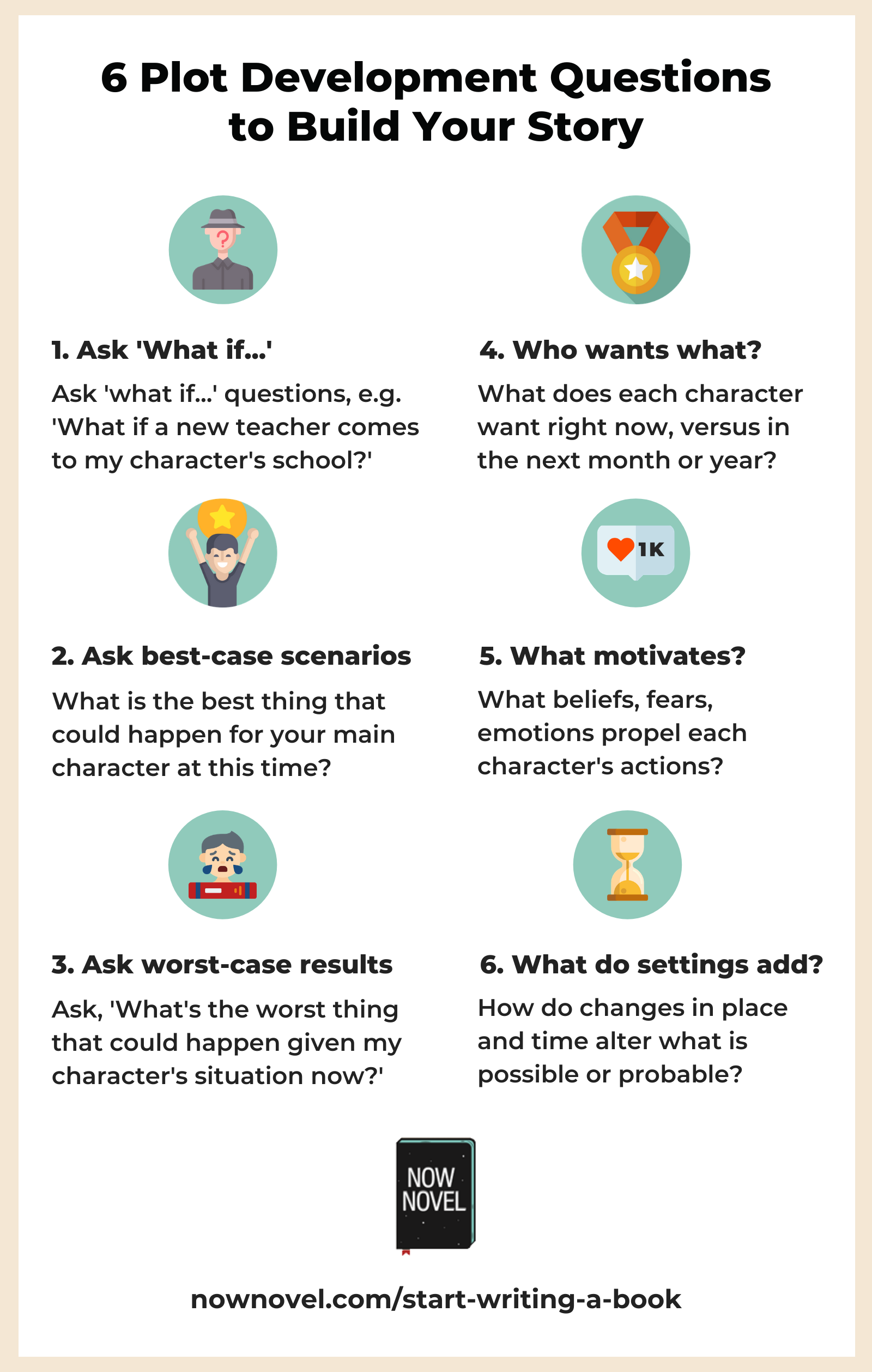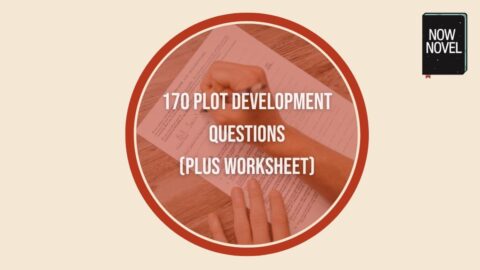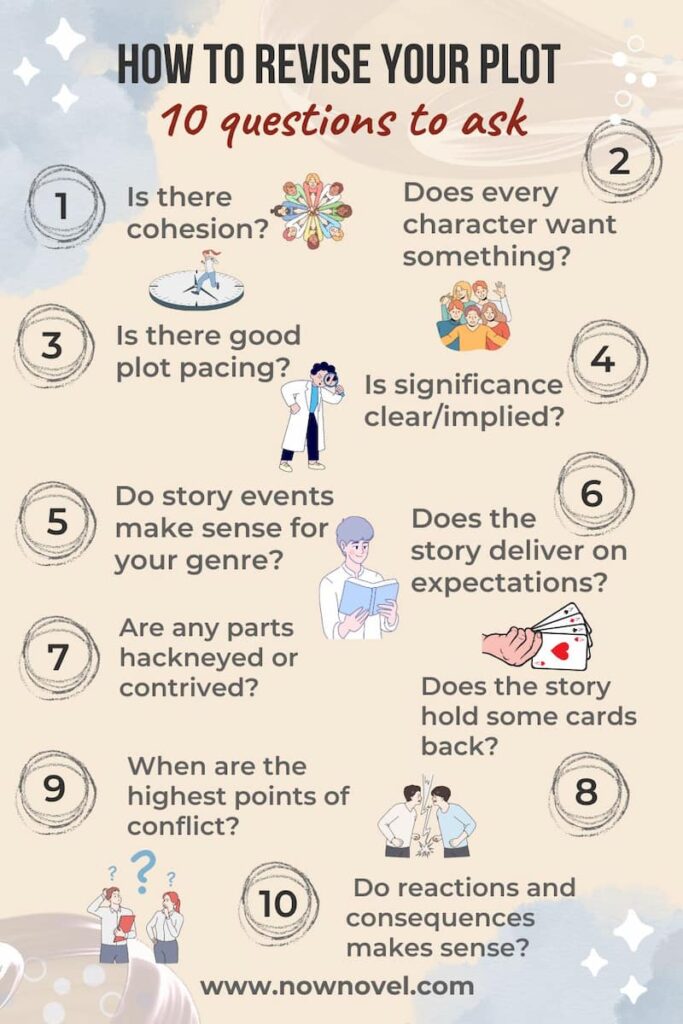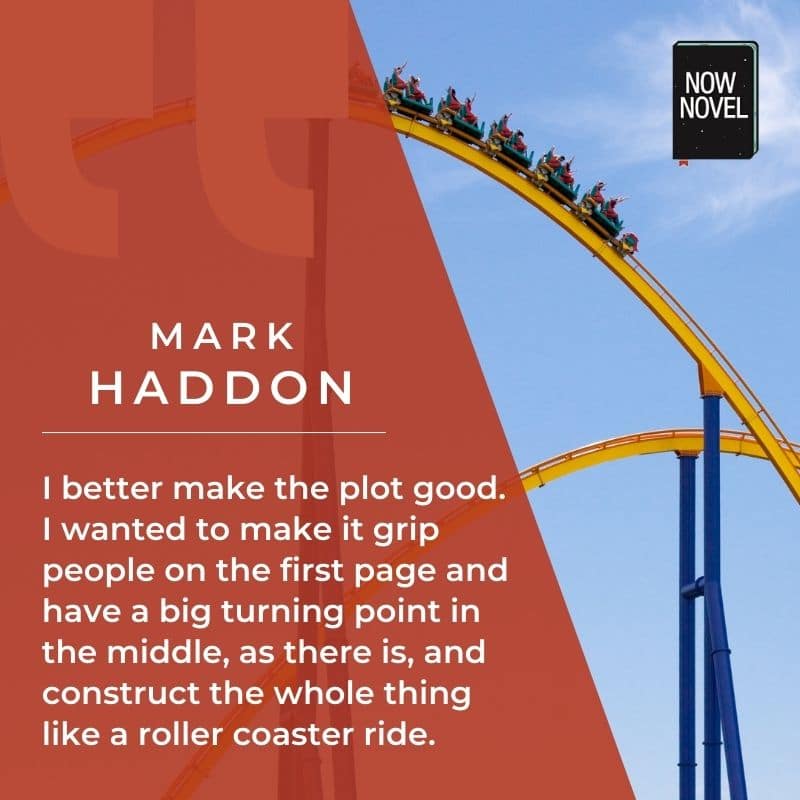Productive plot development questions for building stories help you turn the core of a plot idea into a many-layered story. Read 170 plot questions divided into helpful focus categories and answer ‘who, what, why, where, and when’ questions to brainstorm ideas.
100 plot questions from beginning to end
We’ve brainstormed plot questions based on crucial elements of plot.
Jump to the relevant section using the links below:
- Beginnings and inciting incidents
- Goals
- Motivations
- Conflicts
- Middles
- Plot and setting
- Mystery and unknowns
- Turning points and reversals
- Rising action and climaxes
- Endings
After, scroll down to find a handy worksheet of all these questions plus seventy extra on the seven basic plots.
Plotting beginnings and inciting incidents
The beginning of a story needs several plot elements:
- Exposition (introduction to significant details such as key characters, settings and a situation or scenario)
- A hook (the unanswered question or open possibility that makes your reader commit to the story). You could also call this the ‘story question’: what are your main characters questioning in your story, what difficulties are they facing? What is the central question or central conflict of your story?
- A sense of or hint toward genre (if you’re writing genre fiction with fairly fixed reader expectations and not a more sui generis or hybrid sort of story). Remember that with genre such as fantasy or science fiction, romance or mysteries you’re working within predetermined genre conventions: a happy ending for romance, the murderer is caught in a mystery and so on.
- Direction/purpose (the sense the story is moving towards a revelation, conflict, change, intrigue of some kind)
- An inciting incident (an event or development within the first third of the story that gives a reason to act or signals impending, significant change)
Plot questions for beginnings
- Who is the main character or protagonist (or group of characters)?
- Who is behind the first significant change to the story’s starting scenario? [For example, the children’s uncle creates magical rings in C.S. Lewis’ The Magician’s Nephew and this is the catalyst for their travel between Earth and magical woods that hold a portal to Narnia among other worlds].
- What is the most important thing the reader should know about the main character or their world upfront (that will shape the story most)?
- What is the inciting incident, the catalytic event that sets change in motion?
- Why does the protagonist’s world become unstable/disrupted, giving them reason to act?
- Why can’t things stay the same with no action taken?
- Where does the first key event in this story occur?
- Where does this first event take a character (or characters) that they’ve never been before?
- When does a main character decide to act, despite potential risks, dangers or challenges?
- When will the main character(s) first realize the challenges and potential complications of the task ahead of them?
Plotting goals (desires driving plot development)
Goals, motivations and conflicts are crucial parts of plot. Kurt Vonnegut said every character should want something, even if it’s just a glass of water.
What characters (or larger systems or entities) want, why they want it, and what obstacles or internal or external conflict will make attainment hard?
Story goals for plotting share a lot with ‘SMART’ goals because it can help your plotting process if they are:
- Specific (i.e. more detailed, concrete, have some scope – not just ‘defeat Sauron’ but ‘destroy the One Ring that could restore Sauron to full power’)
- Measurable (there is some way of measuring progress made, e.g. distance left to a destination or tasks required for a qualification or promotion)
- Attainable (although a sense of impossibility may make the path to a goal more suspenseful)
- Realistic (mammoth goals such as ‘world peace’ may have too many required actions for one story, though this depends on whether the story is a ‘realist’ or a more fantastical one)
- Time-based (in plotting, giving a limited time for characters to act creates in-built urgency)
Plot questions for developing goals in stories
- Who will support your character most in pursuing their greatest goals?
- Who will hinder them most?
- What is your character’s first goal in the story?
- What is their ultimate goal? [This is the telos or end point that drives their arc – you might come back to this as drafting reveals it to you.]
- Why are your character’s goals important to them?
- Why would not attaining their goals be a travesty?
- Where will your character’s goals take them first (what previously unvisited location)?
- Where will they first encounter something that makes them doubt their goals or resolve?
- When will your character first receive help toward their greatest goal?
- When will they first experience a setback in pursuing this goal?
Plotting motivations beneath characters’ goals
Author David Corbett calls motivation the ‘compass of character’ (The Compass of Character: Creating Complex Motivation for Compelling Characters in Fiction, Film, and TV, 2019).
It is a good term because it suggests that what we want shapes how we talk, act, find our way (even if we don’t always consciously know what that ‘X’, the treasure located on the map, is at the start of telling a story).
Corbett breaks character motivation down into four helpful elements:
- Lack (what a person wants but does not yet possess, innately or acquired)
- Yearning (what a person longs for)
- Resistance (an inner obstacle against being true to desire, Corbett gives examples such as wounds, weaknesses, flaws)
- Desire Corbett describes this as the culmination of the previous three elements of motivation. Lack, yearning and resistance combine in something appearing – a ‘what if’, person or thing – that moves the character to act
Keeping the above in mind:
Plot development questions for motivations
- Who among the characters introduced to begin the story has what kind of lack? List your characters and write down a lack for each.
- Who yearns for what out of your starting line-up of characters? Write down a deep-seated longing for each [Examples: love, wealth, fame/recognition, company, healing, happiness].
- What is an initial source of resistance for your character pursuing their first goal, if any (and what action or reaction beat does this resistance lead to)?
- What helps your character overcome their initial resistance (e.g., this might be advice, new information, a sudden change of circumstance).
- Why does your character desire what they do at the start of the story?
- Why does what your character wants change as the story develops (if it does change in major or minor ways)?
- Where does their desire or resolve feel strongest (and why)?
- Where does their desire or resolve feel weakest (and why)?
- When will the first event that strengthens their motivation or resolve occur?
- When will the first event that tests or diminishes their motivation or resolve occur?
Let’s explore plot development questions for when the best intentions are thwarted (questions to create conflicts):
Plotting conflict and tension
After characters discover goals and motivations, this leads them into conflict situations. The new fashion intern meets the Miranda Priestly. The budding witch or wizard meets a snotty rival.
Tweet This
As your plot grows towards the middle, there will be more complications. Conflict in plot arises out of complications such as:
- Rival goals or desires (competition) – a ‘person vs person’ type of struggle
- Misunderstandings and miscommunication
- Clashes (of personalities, values)
- Destructive ideologies (for example prejudices and supremacies)
- Intolerable lack (lack of freedom, resources)
- Hostile environments (for example, a difficult mountain pass with tricky crossings)
Keeping the above in mind, here are ten plot development questions for brainstorming conflicts that could arise in a story:
Plot questions to brainstorm conflict
- Who might your character clash with in pursuit of their goals, and why?
- Who (if anyone) has a hidden agenda that could make it harder for your character to overcome a first or later conflict?
- What does the main character stand to lose if they don’t overcome the first conflict?
- What flaws or personal resistance hinders your character in overcoming the first and subsequent conflicts they encounter?
- Why is overcoming the first conflict crucial for this character’s progress or success?
- Why is this conflict triggered in the first place?
- Where does the first conflict begin vs end?
- Where might unforeseen consequences of this conflict crop up later?
- When will (or might) this conflict resolve, what conditions will that require?
- When the conflict resolves, what could each character involved have gained or lost (physically or emotionally)?
Next up, questions to develop plot middles (and avoid a middle that dissipates the story’s tension or focus):
Plotting the middle of a story
The middle of a story, the second act in three-act structure, is a bridge between departure and return, or rags and riches, or other polar (or circular) beginnings and endings.
In Story Trumps Structure, Stephen James describes a method of starting a countdown at the middle of your story in your mind towards the end of your book. Maybe there is less time for characters to achieve what they need to. More urgency.
This is a helpful way to make sure that each part from the mid-point onwards is primed for a sense of purpose, relevant to your overarching plot.
The middle typically brings
- Complications
- Further conflicts
- Enlargement of the promise held out by the story’s beginning (according to author Zara Altair)
- Possible loss of a straightforward path due to complication (bringing the need for ingenuity, perhaps, or trial and error, backtracking, finding help)
Plot questions to brainstorm the middle of a story
- Who might your character meet in the middle of the story for the first time? Do they offer help or hindrance?
- Who might no longer be a source of help, advice or guidance due to plot complications or circumstances in the middle?
- What could be harder or more complex at this point in the story?
- What does your character still not know (and need to learn) at this point in the plot?
- Why will the way ahead not be straightforward or predictable for the character?
- Why is there a good chance your character could fail in what they need to do?
- When does a major setback occur that makes your character’s task seem nearly impossible?
- When does a ticking bomb (figuratively speaking) or other time element get introduced that makes swift action crucial?
- Where does the main character find unexpected allies, help or resources?
- Where is the main character when they realize their former plan or hypothesis won’t work, or they gain vital new information?

GET YOUR FREE GUIDE TO SCENE STRUCTURE
Read a guide to writing scenes with purpose that move your story forward.
Learn morePlot and setting questions
Like plot and character, plot and setting are closely intertwined. After all, a change of location may bring new conflicts, constraints on possible actions (and reactions), and thus new scope for the possible or impossible (in Narnia, the Pevensie children can’t just ring their parents and say ‘This sucks, come fetch me’).
Interesting aspects of setting to think about as you answer plot development questions are:
- Era or time period (what can vs cannot happen in this era?)
- Place context (what is plausible or implausible for where and when your story’s set?)
- Setting change (how do the plot events of your story shape setting in a reciprocal way? It is likely destructible, subject to the consequences of action and reaction in your story in some ways).
Keeping the above in mind, questions to develop your plot in tandem with setting:
Setting-related plot development questions
- Who might your character meet in each of your story’s major locations, who inhabits each area?
- Who is happiest in any new destinations the story takes us to, vs who is least happy (and why)?
- What can’t your character do due to time or place at the start of the story?
- What freedoms, capabilities or possibilities arise, change or diminish as the story’s locations change [For example, a character travelling to a religiously conservative land may have to go out with a retinue or in disguise]?
- Why does the setting undergo significant changes (due to war, natural disasters, etc.) and how do these changes impact the plot?
- Why does your protagonist need to navigate different settings (e.g., city vs. wilderness, different planets, etc.) to achieve their goal?
- When might the history or past events of your setting influence the events of your plot (and why)?
- When does the setting impose certain laws or necessities, and what are the consequences if your character breaks them?
- Where will the plot of the story reach its climax?
- Where will your main character(s) feel most out of their element, and how will this affect their actions or choices?
Plotting mysteries and unknowns
Plot in stories moves between two poles – the known, and the unknown. How you eke out giving the reader known context, facts, world detail, and what you leave mysterious combines to create suspense.
Leaving some mysteries and unknowns (and not revealing your whole hand at once with, for example, a prologue that tells all or a whole lot of foreshadowing) gives your reader a good reason to continue. Mystery and the unknown:
- Invite questions
- Stimulate the imagination
- Expand possibility (inviting interpretation, assumption, guesswork)
Keeping this in mind, questions to brainstorm unknowns and mysteries in your story:
Plot development questions to create mystery and unknowns
- Who in the story has or will reveal a secret (whether their own or someone else’s), and how might this revelation alter the course of events?
- Who in the story has the most knowledge of an important mystery, and who has the least? Why?
- What is your main character’s most pressing question at the start of the story (and what must they do to find an answer)?
- What can the reader safely assume (and what is it not safe to assume) based on the events of the first scene or chapter?
- Why does your character need to find out a crucial mystery?
- Why will this revelation be hard to make?
- When does your protagonist realize that someone they trust is hiding a secret or key information?
- When does your protagonist realize initial assumptions or beliefs were mistaken? [Think of Lizzie Bennet realizing Darcy’s nobler intentions in Pride and Prejudice]
- Where does an event occur which deepens the plot’s mystery and confounds your protagonist?
- Where does a key character go missing or quiet and what’s the reason and impact on subsequent events?
Plotting turning points and reversals
Turning points in a story are where a character must make a decision that will affect the rest of the story. For example, moving to another city..
Reversals (or reversals of fortune) are big changes a character (and the reader) don’t necessarily see coming. Sudden windfalls, for example (like Pip’s unexpected inheritance in Dickens’ Great Expectations).
Turning points and reversals develop your plot by:
- Creating dynamic, contrasting change. They may not require as much build-up as (for example) an inevitable showdown with a final adversary
- Creating suspense. A sudden windfall or misfortune blows wide further possibilities for what could happen next or down the line
- Is a dramatic effect that is best used sparingly. If you have a radical narrative shift every other scene or chapter, you could give your reader whiplash with all the dramatic change. This is a staple of some genres though (e.g. soap opera and other genres that favor melodrama)
With this in mind, let’s explore plot questions to develop turning points and reversals:
Questions to create turning points and reversals in plots
- Who in the story has a sudden reversal of fortune or fate?
- Who or what is responsible for a main character’s reversal in the story?
- What is the first major turning point in your main character’s progress, a decision or action that changes everything?
- What future event will this turning point make the reader anticipate?
- Why does your main character benefit or suffer from a major reversal?
- Why is a turning point necessary so that a main character may achieve what they desire?
- When will the first major turning point in the story occur?
- When will a significant reversal of fortunes (e.g. the loss of a friend or companion, or discovery of new resources) occur?
- Where is the action unfolding when the first major turning point occurs?
- Where is a main character when they experience a major reversal (or learn about events which portend one)?
Plotting rising action and climaxes
‘Rising action’ is the term describing events that increase in suspense, intensity and urgency towards a climax an resolution or denouement (when ‘the strands of the plot are drawn together’ OED).
Rising action and climaxes are naturally more intense in genres such as epic fantasy, thrillers and crime that revolve around tense situations and conflict. Yet even a feel-good romance has rising action as the story gets closer to lovers uniting (and romantic tension goes from a simmer to boiling point).
Plot questions for creating rising action and climaxes
- Who needs to achieve what more urgently by the middle of the story?
- Who is working against the protagonist openly or in secret to prevent them reaching their goal (and why)?
- What happens in the third act or segment that makes the path to what your character wants harder?
- What personal sacrifice or compromise must your protagonist make to move forward?
- Why is an adversary or naysayer determined to oppose a main character’s desires?
- Why does your protagonist face a substantial setback (and how do they recover from it)?
- When will the rising action to the climax reach its highest point of tension (what’s the ‘make or break’ moment)?
- When will the climax force your main character(s) to confront their biggest flaws or limitations?
- Where will your character’s progress in fulfilling their desire be hardest?
- Where does the climax take place (and how does place add to the tension or sense of the unknown)?

Plotting story endings
How do you end a story? Creating the sense of an ending is part of what leaves a satisfying impression on readers. The ending of a story or book will ideally:
- Deliver on the promises set up at the start of the story. For example, a ‘happy for now’ or ‘happily ever after’ ending in the feel-good romance genre
- Resolve important narrative threads. There is leeway to be experimental in more literary stories of course, e.g. Bret Easton Ellis ending a novel mid-sentence in The Rules of Attraction. In this case irresolution speaks to the ephemeral subject matter of young drug users’ wild lives)
- Speak to key themes, concepts and ideas. The example of an unconventional ending above still fits the nature and tone of the story (for example the story explores trauma and other events which interrupt lives and human stories and sometimes don’t have resolution)
Read ten questions to ask to develop a satisfying ending:
Plot questions to develop good endings
- Who gets what they want by the end of the story, and who doesn’t (and why)?
- Who has your main character become (what has changed in them through the experience they’ve undergone)?
- What answer to an explicit or implicit question is revealed in the story’s final pages (for example, whether it is better to be blissfully unaware and ignorant or to find out and to suffer)?
- What will the reader be surprised or comforted to read in the final pages?
- Why does a character’s defeat or redemption bring a satisfying sense of closure (or leave an element of ‘to be continued’, if this will be a title in a series)?
- Why does the main character’s success or failure in pursuing their desires ring true to the story’s subjects or themes?
- When does your protagonist achieve their goal, bringing a satisfying sense of conclusion?
- When does the story’s central mystery or greatest unknown get answered, tying up loose ends (for example, whether a couple will end up together, whether a villain will see their comeuppance).
- Where does the ending leave your character(s), in a place of harmony and rest or with new trouble brewing (and how does the ending hint at said trouble)?
- Where do characters’ relationships or dynamics end up, resulting in new understanding or strengthened bonds?
70 extra plot questions for the seven basic plots
We’ve previously discussed the seven basic plots, which Christopher Booker discusses in The Seven Basic Plots: Why We Tell Stories.
Get seventy extra plotting questions on the seven types, such as ‘rags to riches’ and ‘overcoming the monster’, as well as all the above questions in one handy document, in our free workbook of plot development questions here.
🗣️ Which of the above questions resonated with you? Or do you have your own plot question for brainstorming to share with fellow readers? Tell us in the comments!
Learn more about Group Coaching, a structured, six-month course with daily drop-in writing sprints, Q&As with experienced authors and writing coaches, weekly writing workbooks, story planning tools, and hands-on help to make concrete progress with your story.






6 replies on “170 plot development questions (plus worksheet)”
This is greatly appreciated… and rather overwhelming. I’m going to print the worksheet out and explore this in chunks. With a pencil and a big eraser. Then I’ll move on with the end of my first draft, hoping I’ve gained some insight through osmosis. Then I’m going to revisit the worksheet and tackle draft two. I’ll keep a paper bag and tissues handy. Haha, just kidding. All part of the process and the fun. Keeping the info coming. Thank you!
Hi Margriet, thank you for your feedback. I’m glad to hear that it is overwhelming as maybe 170 is too many prompts :). I would treat them as all optional, dipping in to answer whichever one grabs your attention or stirs a thought (this is sort of how I use writing manuals – dipping a toe in here, a pinky in there). It’s a pleasure, thank you for sharing your thoughts!
Thank you for this!! This is very much valued.
Hi Ope, I’m glad to hear that. It’s a pleasure, thank you for reading and sharing your feedback.
This is so appreciated. It’s going with me on my writing retreat. Thanks!
Oh, that’s excellent to hear, Jacci! Have fun on your retreat and wishing you a productive time there.